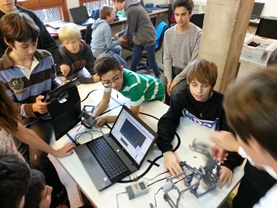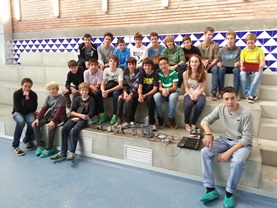Què és i cóm funciona una turbina hidroelèctrica, Setmana de la Ciència, Escola Garbí, Esplugues
19-11-13
Durant la 18a Setmana de la Ciència, els alumnes de l'Escola Garbí d'Esplugues varen dur a terme diferents activitats i tallers relacionats amb l'aigua, tema triat per l'escola. Podeu veure un resum a la web de l'Escola Garbí.
Des del Departament de Tecnologia de l'Escola Garbí es va proposar el taller "Què és i cóm funciona una turbina hidroelèctrica" al qual varen participar 19 alumnes de la ESO dels quals 4 van venir de l'Institut Icària de Barcelona per realitzar el taller i passar tot un dia a Garbí.
Els alumnes, distribuïts per grups, varen construir amb peces de LEGO diferents tipus de turbines semblants a les que utilitzen les centrals hidroelèctriques i les varen connectar a un robot de LEGO per tal d'observar i relacionar els paràmetres que intervenen en la generació d'energia, com ara el cabal, l'alçada de la caiguda de l'aigua i la geometria de la turbina. Els alumnes van escriure un programa per visualitzar dinàmicament en temps real la captura de dades del sistema, generant gràfics de corbes en funció del temps que van aprendre a interpretar per entendre millor la generació d'energia correlacionant els diferents paràmetres. L'experiment final de presa de dades del sistema es va realitzar a la piscina de l'escola. Finalment, els alumnes van preparar una presentació per tots els alumnes de Secundària que es va realitzar per la tarda. Els alumnes també van estudiar com l'aprofitament de l'energia hidràulica va començar als pirineus a finals del segle XIX amb els molins de blat, als quals a inicis del segle XX se'ls hi van afegir microcentrals hidroelèctriques amb un impacte mínim al territori. Aquests molins i microcentrals hidroelèctriques, que en l'actualitat estan abandonats i molts destruïts, suposen un gran patrimoni disseminat pel territori que caldria recuperar. Finalment, es van crear les grans centrals que varen suposar un impacte molt més gran degut especialment als grans embassaments. Va ser una jornada divertida i molt didàctica que es va compartir amb alumnes de fora de l'escola. A més, l'experiment va ser tot un èxit tal com es pot veure a les imatges i vídeos del taller. Podeu consultar la presentació dels alumnes en PDF.
Aquest projecte es va presentar al Concurs de professors inGenious de la UE.
During the 18th Science Week, Garbí School students of Esplugues undertook different activities and workshops related to water, theme chosen by the school. You can watch a summary at the Garbí school website.
The Technology Department of Garbí School proposed the workshop "What is it and how a hydroelectric turbine works" where 19 high school students participated from whom 4 came from Barcelona Icària High School to attend the workshop and stay a whole day at Garbí.
The students, distributed in groups, built a turbine with LEGO pieces, similar to the ones used in hydroelectric power plants, and connected it to a LEGO robot to observe and relate the parameters that play a role in the generation of energy, like the water flow, the water falling height and the turbine geometry. The students wrote a program to dynamically visualize in real time the data capture of the system, generating graphs of curves in function of time, which they learnt to interpret to better understand the generation of energy correlating the different parameters. The final system data capture experiment was done at the swimming pool of the school. Finally, the students prepared a presentation for all the high school students, that was done in the afternoon. The students also studied how the hydraulic energy use started at the Pyrenees at the end of the XIX century with wheat mills, to which micro hydroelectric power plants were added at the beginning of the XX century with a minimum territory impact. These mills and micro hydroelectric power plants, which at present are abandoned and many destroyed, represent an important heritage sprawled through the whole territory that should be recovered. Finally, the big hydroelectric power plants were built and these implied a much bigger impact especially due to the big reservoirs. It was a fun day and very educational that was shared with foreign students. In addition, the experiment was very successful, as you can see through the images and videos of the workshop. You can watch the student presentation in PDF.
This project was presented to the EU inGenious Teacher Competition.


Des del Departament de Tecnologia de l'Escola Garbí es va proposar el taller "Què és i cóm funciona una turbina hidroelèctrica" al qual varen participar 19 alumnes de la ESO dels quals 4 van venir de l'Institut Icària de Barcelona per realitzar el taller i passar tot un dia a Garbí.
Els alumnes, distribuïts per grups, varen construir amb peces de LEGO diferents tipus de turbines semblants a les que utilitzen les centrals hidroelèctriques i les varen connectar a un robot de LEGO per tal d'observar i relacionar els paràmetres que intervenen en la generació d'energia, com ara el cabal, l'alçada de la caiguda de l'aigua i la geometria de la turbina. Els alumnes van escriure un programa per visualitzar dinàmicament en temps real la captura de dades del sistema, generant gràfics de corbes en funció del temps que van aprendre a interpretar per entendre millor la generació d'energia correlacionant els diferents paràmetres. L'experiment final de presa de dades del sistema es va realitzar a la piscina de l'escola. Finalment, els alumnes van preparar una presentació per tots els alumnes de Secundària que es va realitzar per la tarda. Els alumnes també van estudiar com l'aprofitament de l'energia hidràulica va començar als pirineus a finals del segle XIX amb els molins de blat, als quals a inicis del segle XX se'ls hi van afegir microcentrals hidroelèctriques amb un impacte mínim al territori. Aquests molins i microcentrals hidroelèctriques, que en l'actualitat estan abandonats i molts destruïts, suposen un gran patrimoni disseminat pel territori que caldria recuperar. Finalment, es van crear les grans centrals que varen suposar un impacte molt més gran degut especialment als grans embassaments. Va ser una jornada divertida i molt didàctica que es va compartir amb alumnes de fora de l'escola. A més, l'experiment va ser tot un èxit tal com es pot veure a les imatges i vídeos del taller. Podeu consultar la presentació dels alumnes en PDF.
Aquest projecte es va presentar al Concurs de professors inGenious de la UE.
During the 18th Science Week, Garbí School students of Esplugues undertook different activities and workshops related to water, theme chosen by the school. You can watch a summary at the Garbí school website.
The Technology Department of Garbí School proposed the workshop "What is it and how a hydroelectric turbine works" where 19 high school students participated from whom 4 came from Barcelona Icària High School to attend the workshop and stay a whole day at Garbí.
The students, distributed in groups, built a turbine with LEGO pieces, similar to the ones used in hydroelectric power plants, and connected it to a LEGO robot to observe and relate the parameters that play a role in the generation of energy, like the water flow, the water falling height and the turbine geometry. The students wrote a program to dynamically visualize in real time the data capture of the system, generating graphs of curves in function of time, which they learnt to interpret to better understand the generation of energy correlating the different parameters. The final system data capture experiment was done at the swimming pool of the school. Finally, the students prepared a presentation for all the high school students, that was done in the afternoon. The students also studied how the hydraulic energy use started at the Pyrenees at the end of the XIX century with wheat mills, to which micro hydroelectric power plants were added at the beginning of the XX century with a minimum territory impact. These mills and micro hydroelectric power plants, which at present are abandoned and many destroyed, represent an important heritage sprawled through the whole territory that should be recovered. Finally, the big hydroelectric power plants were built and these implied a much bigger impact especially due to the big reservoirs. It was a fun day and very educational that was shared with foreign students. In addition, the experiment was very successful, as you can see through the images and videos of the workshop. You can watch the student presentation in PDF.
This project was presented to the EU inGenious Teacher Competition.






























